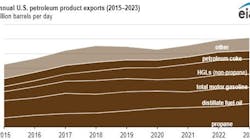Sam Fletcher
OGJ Senior Writer
Despite the overhanging pall of the tragic Macondo blowout in the Gulf of Mexico, the 2010 Offshore Technology Conference on May 3-6 in Houston was generally upbeat with business better than a year ago and hopes of steady improvement through the rest of the year.
“Overall, inbound orders and activity are improving. Manufacturing companies have not really been able to push pricing higher yet, but business is much healthier than a year ago when the industry's focus was on implementing numerous cost-cutting measures (‘survival mode’),” said analysts in the Houston office of Raymond James & Associates Inc. “Based on our numerous conversations, the hottest business in the sector is pressure pumping,” they said.
Meanwhile, energy investors are trying to anticipate the likely impact of possible new regulations on the oil and gas industry and which companies ultimately will be held liable for punitive damages in the congressional outrage over the recent blowout in the gulf, said analysts at Pritchard Capital Partners LLC in New Orleans. Stock valuations of companies active in the gulf in the week ended May 7 “were down approximately 10%, in-line with the sector average, suggesting that the oil spill…has been incorporated into valuations for the time being. On a positive note, most exploration and production companies reported either a reduction or no increase in their gas rig count,” they said.
US Interior Secretary Ken Salazar’s decision to halt issuance of offshore drilling permits for the rest of May will only affect the jack up drilling market—rigs with their blowout preventers on the deck rather than on the seabed as with the deepwater floaters. “Interestingly, the rolling average of permits issued has been above 18/week for the past month, and the 3-week lag will not lead to any floaters stopping turning to the right,” said Pritchard Capital analysts. “However, the uncertainty [of] what happens after the end of May and how fast new permits are issued will still weigh on the stocks. We would avoid the mat rig guys with near-term contract rollovers but believe the other gulf jack up guys should not have adverse effects.”
Salazar’s order extends beyond the gulf and affects permits pending in Alaska. DOI employees can continue to approve drilling plans and work on permits even though the permits will be withheld.
Euro zone crisis
The front-month crude contract fell to an intraday low of $74.51/bbl on May 7 in the New York market, but rebounded in early trading May 10 after European policymakers came up with a $962 billion emergency loan aimed at resolving the financial crisis of the euro zone.
Amid fears the European debt crisis will slow a global economic recovery, the June contract for benchmark US light, sweet crudes lost $2 to close at $75.11/bbl on May 7 on the New York Mercantile Exchange. The June natural gas contract gained 8.6¢ to $4.02/MMbtu on NYMEX.
“Even a bullish report from the US Labor Department showing that 290,000 jobs were added to payrolls in April, the biggest payroll jump in 4 years, could not stem the downward slide of crude oil. However, the positive steps taken by the European Union are likely to stem the euro’s collapse and will also calm some nerves in the broader market,” said Pritchard Capital analysts at Partners.
“Oil has climbed off its 12-week lows as fears that the crisis would derail the global economic recovery begin to subside,” Raymond James analysts said May 10. “Gas continues to rise after posting a 2% gain [on May 7] despite another bearish storage report released last week.”
The price of West Texas Intermediate dropped more than 10% during the first week in May. “Although many comments in the trade press cite the rise in the value of the US dollar as the main factor, we think another financial dynamic has been more important, Standard and Poor's 500 index,” said Adam Sieminski, chief energy economist, Deutsche Bank, Washington, DC.
“For the last 6 months, oil was moving up as the dollar strengthened,” However, he said, “Starting in March 2009, the relationship between the broad stock market index and oil prices has been remarkably consistent; every 65-70 point gain on the S&P 500 has been worth about $5/bbl on the crude oil price.
“Since October, over 60% of the movement in WTI prices is explained by the S&P 500. For the last 6 months, oil was moving up as the S&P 500 strengthened, just the opposite of the long-term inverse correlation between these two variables,” he said.
(Online May 10, 2010; author’s e-mail: [email protected])

